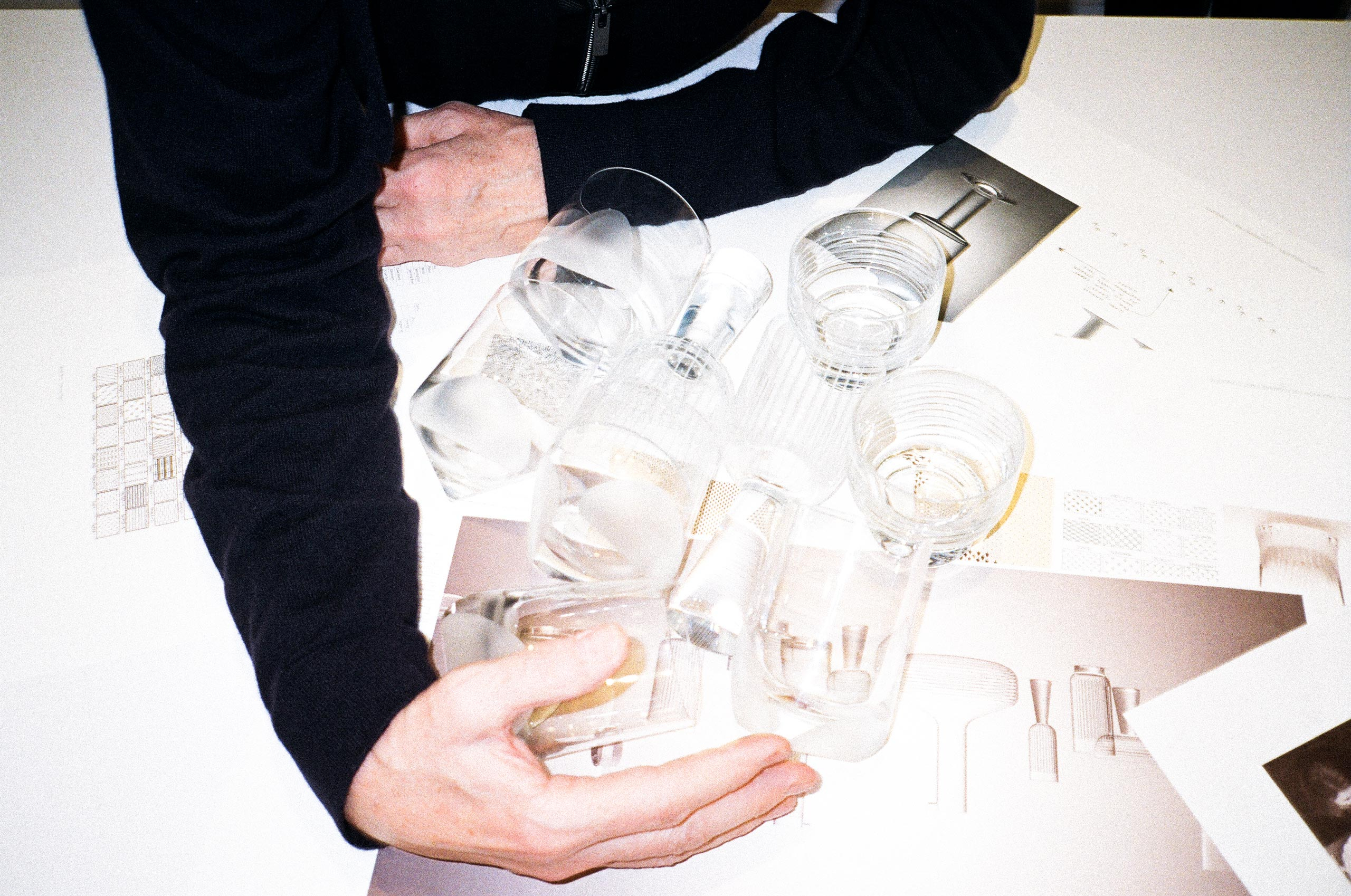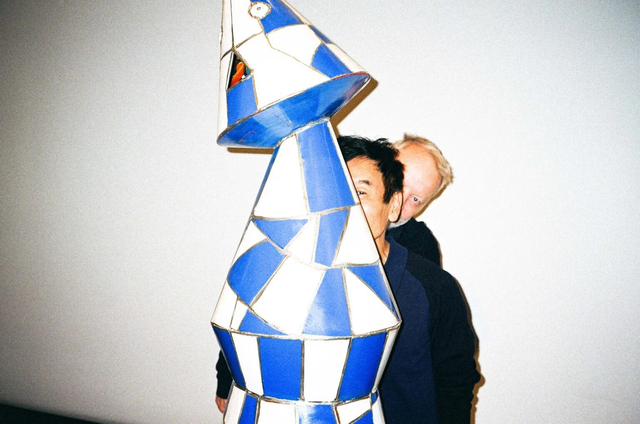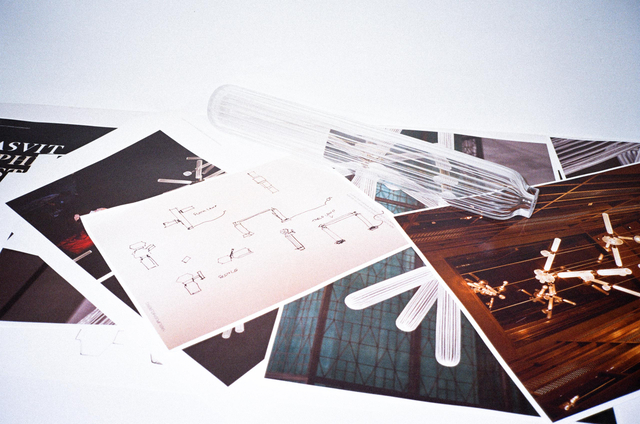Shadow Players
By: Eva Slunečková
Photo: Marie Tomanová
What do you recall when someone says bohemian glass?
Glenn Pushelberg: The first time I visited Prague was 30 years ago. I remember to this day the thing I was most fascinated by was the traditional hand cut glassware. George and I remained fascinated by the country’s ability to cut glass. It was a timeless, traditional craft we never thought we‘d use, but we were fascinated by it. Now we’ve come full circle.
Originally we were talking about designing a collection of glassware accessories for Lasvit – at the end we‘ve created not only a glassware collection, but mainly a more extensive collection. You‘re pretty good at convincing!
George Yabu: I remember the Cipher collection actually started with our dislike for traditional chandeliers (laughing). The faceted glass has always been too gemlike for our liking. Refraction of light was something we thought about, and we wanted to get it piercingly straight, refined as such a tight line. We were fascinated by that and the technology of laser light because of how sharp and precise those lines are. In exploring Otto, our inaugural collection with Lasvit, we wanted to marry this notion of refraction precision with the heritage of crystal craftsmanship.

Finding new path in design is usually a question of expperiments, which require patience and luck. Such as when George found the defining principal for Otto glassware. The solution was waiting there, it was enough to look at the glass from a different angle — through a stream of light.
How long have you been designing them both?
George: The desire was always there to create something with precise, clean lines. It was the unique and exceptional craftsmanship behind the company that allowed us to transform our dream into reality.
The surfaces for the Cipher collection were inspired by exploration of light. Can you describe exactly what you wanted to catch by the decor?
George: We had initially conceived of five different concepts for our first lighting collaboration. There were plays between unstructured blown glass, suspended molten glass orbs, delicate metal frameworks, stacking, textured glass… with Lasvit’s expertise on our side, we knew that, together, we could create something truly new. So we explored a range of possibilities. The Cipher that we know today didn’t take shape until we were in Prague reviewing prototypes. We had an aha moment. During that visit, the prototypes were exceptional to behold, but weren’t quite meeting the vision and essence we aimed to capture when designing the collection in our studio. The aha moment occurred when I took an Otto glass and placed it over a light generator. The resonance was immediate — it was exactly what we were hoping to achieve. Sharp lines shot out, casting precise lines and shadows on the wall. It was a happy accident.
Your original specialty is interior design. Did this background help you design such a multipurpose lighting collection? It‘s often said, that designers create things that solve their own problems.
George: The change felt more like a natural evolution rather than a stark new era. For years, we’d been working with our interior designers to bring new objects to life, however they were missing the key component of industrial design rigor. We had our feet in the water and then naturally began building out a team of industrial designers to drive the process and ensure each new product was the best it could be.
Glenn: The greatest difference between designing a project versus designing a product is actually one of the most satisfying. When designing a hotel, we’re often looking at an eight-year timeline. It’s a slow burn. When designing products, we ideate, we design, we prototype, and that object is brought to life in a year or two. That relatively immediate gratification is deeply satisfying and keeps things exciting.

George and Glenn have been working together for 40 years and form a couple for almost the same period. However, this is not an obstacle for them, on the contrary, they are perfectly attuned to each other.
What kind of atmosphere you wanted to reach?
George: Originally, we saw Cipher as a plug-and-play system; a matrix of different components fitting into varying environments. We have spaces, especially in hotels, that are high volume and where we may need to drop something down a stair, or introduce light to a tight space or a specialized space. In time, we realized we could build the system not only laterally, but could also introduce floor lamps and table lamps to create much more range. From there, we’ve continued to find new shapes and forms. We’ve created everything from a Cipher Christmas tree to grand Cipher chandeliers, small wall sconces to art installations. The ability to continue growing the collection keeps us excited and engaged.
From your enthusiams I assume you‘re personally using Cipher in your projects, right?
Glenn: We are, and it satisfies an amazing range of needs while maintaining a sense of newness and novelty. We opened The Londoner Hotel this fall in Leicester Square and Cipher was used throughout – seamlessly floating above a pre-function bar in a single, horizontal formation, transformed into an art installation above one of the hotel’s public entrances, and most spectacularly, spanning three stories of the hotel’s unique underground programing, punctuated with starbursts each step of these way. The collection feels natural in each of the spaces while still maintaining a unique identity for each purpose. Cipher feels as natural in The Londoner as it does sitting here on my desk in our New York apartment.
George: Another recent installation of Cipher may be found at the Park Lane Hotel in New York. It’s been installed as both linear sconces and as a dynamic chandelier-as-art above one the lobby’s spiral staircases. We’d not yet played with flat-planed geometric formations, but we were able to bring them to life in our own backyard here in New York City. The contrast between these projects – The Londoner and the Park Lane Hotel – is demonstrative of how dynamic Cipher is. The Londoner was a new build, very modern, whereas the Park Lane is actually a renovation, with heritage elements preserved. The collection worked seamlessly across both properties.
Speaking of wide range… How many combinations can you actually create with the collection?
George: Glenn and I went into design so we could avoid doing anything involving numbers, so [laughing] I’ll have to leave the arithmetic to you. I can say with confidence that the options feel limitless. Cipher transforms to fit modern spaces and traditional spaces alike, while its scale ranges from sweet table lamps to multi-story chandeliers. The collection both transforms and is transformative.

“Their dedication and commitment to the art make this collaboration all the more special, as does the personal element. It resonates emotionally,” says George Yabu about the development of the Cipher and Otto collections.
What is important when choosing a light for a home or a hotel?
Glenn: It’s the quality of light that creates mood. It isn’t simply about bright light or dim light, but rather where you put the light. Coming from the floor, a small lamp spreads light to create mood and illuminate the ceiling. Recessed light transforms atmosphere. Then comes the color and intensity of the light. Bright light is energizing, dim light can be soothing and sensual. These elements form quality, and with them we’re able to create highs and lows, moving one’s eye to where the light is, guiding you through a space or highlighting a particular area.
Your hospitality projects work frequently with the topic of luxury. What does luxury mean for you personally?
Glenn: New luxury is qualitative, not quantitative. Those who are knowledgeable, those who are forward thinking or who travel are early adopters. Typically, those people are also looking for qualitative luxury. It’s not about gilding the lily, but rather creating things spatially that evoke emotion. Things that you can connect to. Things you understand and that are thoughtful. They can be comprised of the simplest material and be the most beautiful. Juxtaposed against the most expensive material, it doesn’t need to be equally expensive. It’s about proportions and the way something occupies space in a room. That’s a luxury. Otto and Cipher work with very gentle, simple and refined details. I have a feeling, that this decor creates a very understandable language that feels familiar and comfortable, yet in a very distinctive, approachable and sophisticated way. Seems almost like jewellery.
Since you‘re also a couple, how do you complete each other?
George: It goes back to trust. We’ve been partners in work for more than 40 years, and in life for nearly just as long. We’ve shared experiences and grown alongside one another and together. Feedback is a natural and essential part of our work, and because we have complete trust in one another, we already know how to review. We will continue to have differing opinions from time to time, but the differences are never taken personally.
What is the key factor in your work?
George: Curiosity. And trying to find the answer to something. We’re chasing the emotional resonance you get from a project that works.
Glenn: There is a sense of emotion and power that define our best interiors and most satisfying work. There is a completeness when everything is working in harmony. We hope that what we create resonates and won’t be soon forgotten. It’s not about a bam. We don’t want to be too ephemeral. We want to be lasting.

“Preservation of history. Protection of craft. Unparalleled expertise and a thread of continuity spanning generations,” this is what Glenn Pushelberg values most in working with skilled Czech glass craftsmen.
Do you have a system for dividing types of work in the studio?
George Yabu: We’re both very hands on and like to remain close to the design process. There isn’t a formal system by any means, and we will reverse roles as needed, but I’d say it’s natural for Glenn to take on more of the client-facing tasks throughout the lifecycle of a project. His ability to develop relationships and keep things on track, pushing when needed or keeping firm on something we’re passionate about is a skill he can be completely entrusted with.
Glenn: As George mentioned, we both do a little bit of everything. While I’m flying somewhere to meet a client on the other side of the world, George is the one sitting right alongside our design teams sketching out the details, refining and elevating. His attention to detail makes our work what it is. The curvature to the back of a chair, the angle where two seams meet, or the shade of a textile… He’s attuned to all of these elements and has a beautiful vision that makes them feel alive.
What is the most beautiful thing or place, that you ever saw or visited?
George: The Katsura Imperial Villa in Kyoto. What captivates us is that for a royal residence, it’s extremely humble. That’s what I love about it. The gardens are extraordinary all year round. Rock, stone, water, nature… parts of the gardens are untouched and parts are deeply considered and cultivated. There are meandering moments between dozens of smaller buildings, filled with varying sightlines divided by wandering pathways and sliding screens.
Glenn Pushelberg: Walking a simple stone path, the framing of the views is amazing. There’s a synonymy with the way Haussmann reconceived of Paris in that no matter where you turn, there’s an exceptional sightline ahead of you.
Yabu Pushelberg is an international design firm with studios in Toronto and New York, founded in 1980 by Glenn Pushelberg and George Yabu. Their specialization lies in interior hospitality and residential projects and product design. Yabu Pushelberg studio is part of the Lasvit family since 2017.



